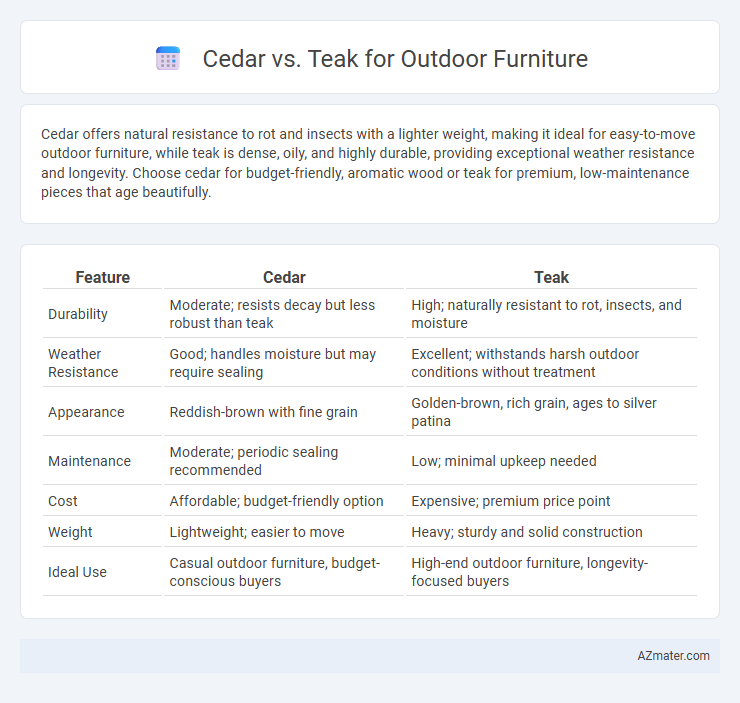Cedar offers natural resistance to rot and insects with a lighter weight, making it ideal for easy-to-move outdoor furniture, while teak is dense, oily, and highly durable, providing exceptional weather resistance and longevity. Choose cedar for budget-friendly, aromatic wood or teak for premium, low-maintenance pieces that age beautifully.
Table of Comparison
| Feature | Cedar | Teak |
|---|---|---|
| Durability | Moderate; resists decay but less robust than teak | High; naturally resistant to rot, insects, and moisture |
| Weather Resistance | Good; handles moisture but may require sealing | Excellent; withstands harsh outdoor conditions without treatment |
| Appearance | Reddish-brown with fine grain | Golden-brown, rich grain, ages to silver patina |
| Maintenance | Moderate; periodic sealing recommended | Low; minimal upkeep needed |
| Cost | Affordable; budget-friendly option | Expensive; premium price point |
| Weight | Lightweight; easier to move | Heavy; sturdy and solid construction |
| Ideal Use | Casual outdoor furniture, budget-conscious buyers | High-end outdoor furniture, longevity-focused buyers |
Introduction to Cedar and Teak Outdoor Furniture
Cedar outdoor furniture is prized for its natural resistance to decay, insect damage, and weather elements, making it ideal for outdoor environments. Teak furniture stands out for its high oil content and dense grain, providing exceptional durability and a luxurious warm tone that ages gracefully over time. Both woods offer distinct advantages in strength, appearance, and maintenance, catering to different preferences and outdoor settings.
Key Differences Between Cedar and Teak Wood
Cedar wood is lightweight, naturally resistant to insects and decay, and has a distinctive aromatic scent that repels pests, making it ideal for outdoor furniture in damp climates. Teak wood is denser, rich in natural oils, highly durable, and resistant to water, which allows it to withstand harsh weather conditions and requires less maintenance over time. The color of cedar ranges from pale orange to reddish hues, while teak features golden brown tones that age to a silver-gray patina if left untreated.
Durability and Weather Resistance Comparison
Cedar offers excellent natural resistance to moisture, decay, and insect damage, making it highly durable for outdoor furniture in moderate climates. Teak's dense grain contains natural oils that provide superior weather resistance, allowing it to withstand harsh sun, rain, and humidity with minimal warping or cracking over time. While cedar may require regular sealing to maintain its durability, teak remains largely maintenance-free, making it the preferred choice for long-lasting outdoor furniture in extreme weather conditions.
Appearance and Aesthetic Qualities
Cedar offers a warm reddish-brown hue that naturally weathers to an attractive silvery-gray patina, enhancing its rustic charm in outdoor settings. Teak showcases a rich golden-brown tone with a smooth, tight grain pattern that ages gracefully to a silver-gray finish while maintaining its structural integrity. Both woods provide distinct aesthetic qualities, with cedar emphasizing natural warmth and texture, and teak delivering a luxurious, polished look favored in high-end outdoor furniture.
Maintenance Requirements for Cedar vs Teak
Cedar requires regular sealing or staining to maintain its natural resistance to moisture, insects, and decay, while teak's high oil content naturally protects it from weathering without frequent treatment. Teak ages gracefully into a silver-gray patina if left untreated, whereas cedar's color and durability decline faster unless maintained properly. Both woods benefit from periodic cleaning, but teak's lower maintenance demands make it a preferred choice for long-lasting outdoor furniture.
Environmental Impact and Sustainability
Cedar and teak both offer eco-friendly options for outdoor furniture, but cedar is more sustainable due to its faster growth rate and abundance in North American forests, leading to lower environmental impact. Teak, harvested primarily from tropical rainforests, often involves concerns regarding deforestation and long transportation emissions despite its durability and natural resistance to elements. Choosing FSC-certified cedar or reclaimed teak further minimizes ecological footprint by supporting responsible forestry and reducing habitat destruction.
Cost and Value Over Time
Cedar outdoor furniture typically offers a lower upfront cost compared to teak, making it an attractive option for budget-conscious buyers. While teak has a higher initial price, its natural oils and dense grain provide exceptional durability, often translating into lower maintenance and longer lifespan, thus increasing its value over time. Investing in teak results in greater long-term cost efficiency due to less frequent replacement and preservation requirements.
Comfort and Practicality in Outdoor Use
Teak wood is highly valued for outdoor furniture due to its natural oils that provide exceptional resistance to moisture, insects, and decay, offering long-lasting durability and low maintenance. Cedar is lighter and softer, providing a comfortable seating experience but requiring regular sealing to protect against weathering and insect damage. Both woods enhance outdoor comfort, but teak's superior weather resistance and stability make it more practical for enduring various climatic conditions.
Best Applications: When to Choose Cedar or Teak
Cedar is ideal for lightweight outdoor furniture in dry, moderate climates due to its natural resistance to rot and insects while remaining affordable and easy to work with. Teak excels in high-moisture environments such as coastal areas because of its dense oil content, which provides superior durability, weather resistance, and minimal maintenance. For long-lasting outdoor pieces exposed to rain or humidity, teak is the preferred choice, whereas cedar suits decorative or seasonal furniture in milder conditions.
Final Verdict: Which Wood is Ideal for Your Outdoor Furniture?
Teak offers superior durability and natural resistance to weather, insects, and decay, making it an excellent long-term investment for outdoor furniture. Cedar, while less dense, provides a pleasant aroma, good resistance to rot, and a more affordable option with lighter weight for easy handling. Choose teak for premium longevity and minimal maintenance, or opt for cedar if you prefer a cost-effective, aromatic wood with moderate durability and a beautiful natural finish.

Infographic: Cedar vs Teak for Outdoor Furniture
 azmater.com
azmater.com